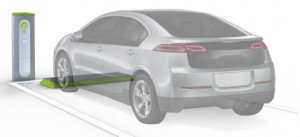 By John Addison (updated 3/28/11; original 3/22/11)
By John Addison (updated 3/28/11; original 3/22/11)
New Hands-Free EV Charger
Google makes innovative use of electric vehicles and charging stations. For employees, Google took an early lead in converting Toyota Prii (yep that’s the official plural of Prius) to be plug-in hybrids. Then Google installed beautiful solar covered parking including charge stations so that electric cars can be charged with sunlight.
At its headquarters, Google is now showing us how to charge hands-free. No plug. No cord. Using Evatran Plugless Power’s inductive charging system, one of Google’s maintenance short-range EVs parks in close proximity of the charger and charging begins. The Evatran unit is Level 2 (7.7 kW, 240V at 32A). The light EV was converted to use the inductive charging.
Google is also conducting other important pilots including testing the new Toyota Prius Plug-in, not a conversion, but the 2012 model from Toyota. Soon, Google will be testing the Honda Fit Electric and other plug-in cars. Several Google founders drive Tesla Roadsters. Google founders Larry Page and Sergey Brin are Stanford University grad student “drop-outs” as is Telsa CEO and Founder, Elon Musk. None regret the decision to change the world a priority over getting their PhDs.
Google is even approved by FERC to be an electric utility. Cloud services will be at the heart of the smart grid and smart charging. Early electric car drivers use Google Maps to find the nearest charging station. Will Google charge your electric cars?
How Inductive Electric Car Charging Works
Historically, inductive charging has been too inefficient, wasting valuable electricity and charging hours. Evatran thinks that they can get to 90 percent efficient; they’re not there yet. How does it work? A Plugless Power vehicle adapter is permanently mounted onto the vehicle. A fixed Plugless Power station, including both a floor-mounted parking block and a separate control tower, is installed in the garage or parking space.
Evatran states that its technology is safe. When the equipped vehicle pulls up to the parking space, the parking block automatically positions itself to align with the vehicle adapter and begins charging. With their electromagnetic induction, no actual flow of electricity occurs between the vehicle adapter and the parking block.
Will inductive charging catch-on? In the late 1990s, inductive charging competed with conductive. Multiple incompatible systems helped kill major electric car success. GM, Ford, Toyota, Honda, Nissan, and all the automakers have devoted years working with utilities to have a common Level 2 J1772 smart charging standard. Now they are going thru the pain of trying to get consumers to install wall-mounted chargers, only to be frustrated with obsolete building codes, over worked city inspectors, and electric utility frontline employees who find reasons to say “No to EV charging.” Adding inductive charging would compound the issues.
General Motors puts Inductive Charging Inside
Automakers are interested in proximity charging inside the car when we fill the cars with collegues or kids with their iPhones, Droids, iPads, games, and other mobile electronics. Powermat is not only receiving a $5 million investment from GM Ventures, Powermat will be offered in many 2012 GM cars to give customers proximity charging of mobile devices inside the car.
What about America’s 14 million fleet vehicles? Inductive charging could be a winner. Fleets can install their own systems without needing a universal standard. Think about taxis that wait in queues. Consider millions of delivery vehicles. Light utility vehicles are popular on university, government, and corporate campuses. These are also good candidates for inductive charging, as Google is demonstrating.
